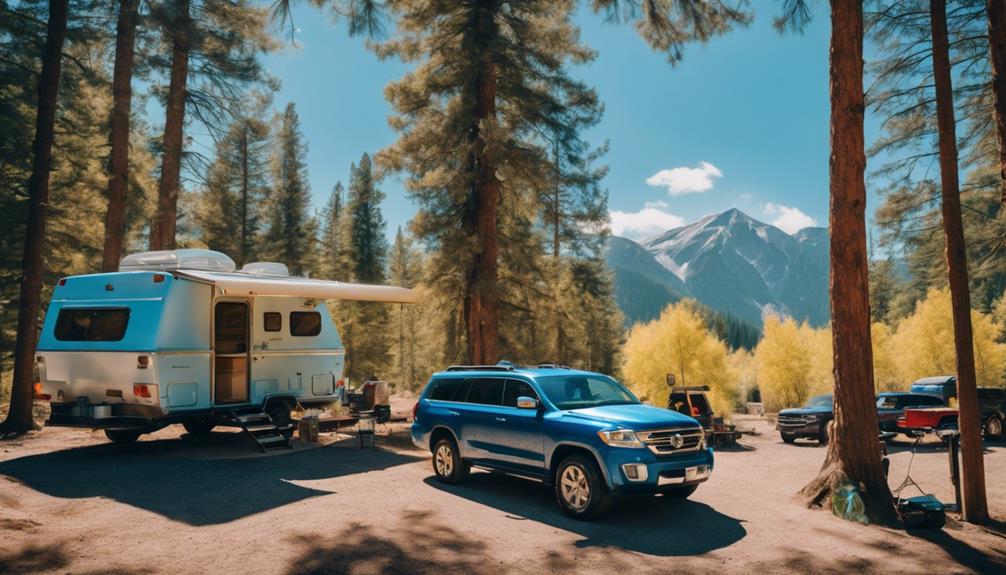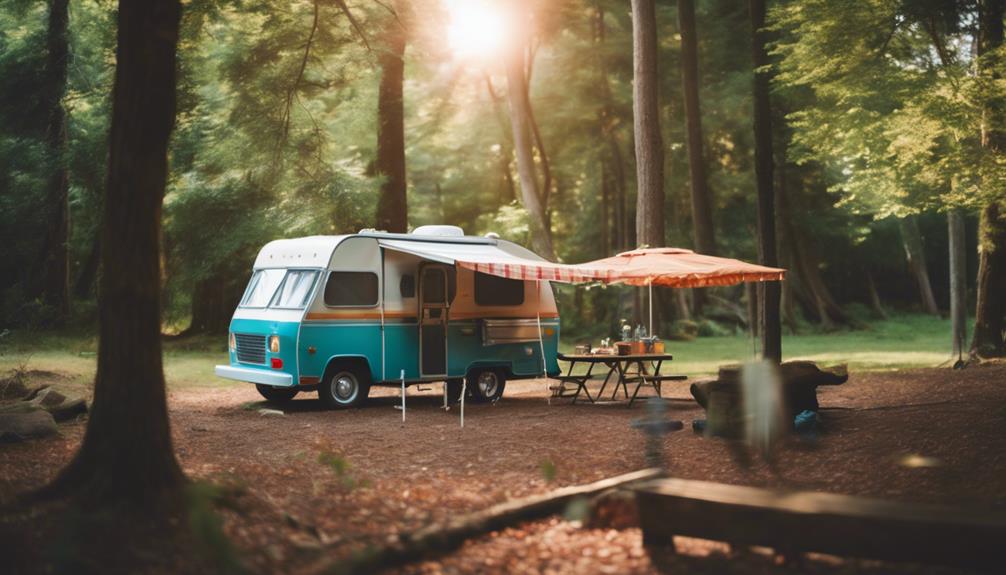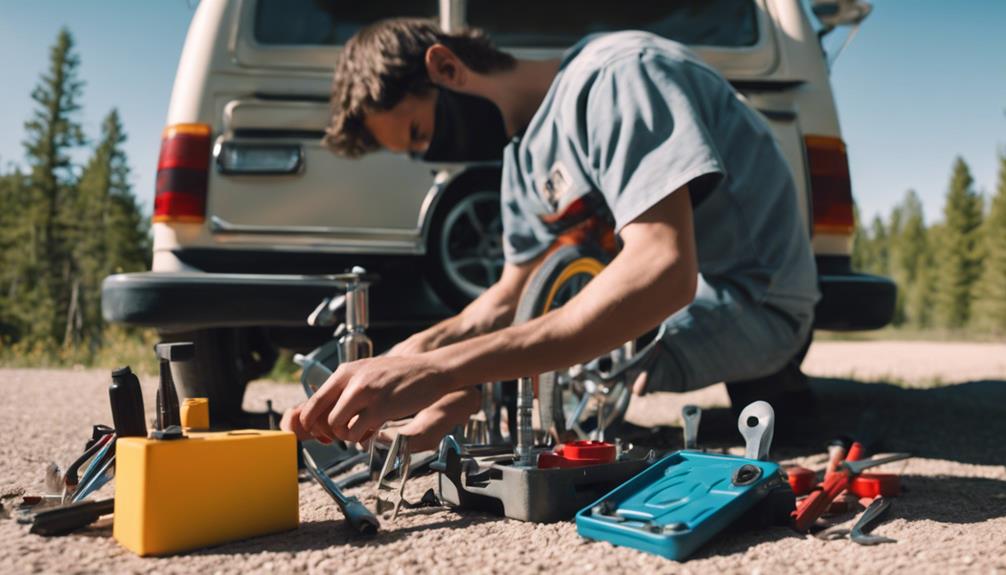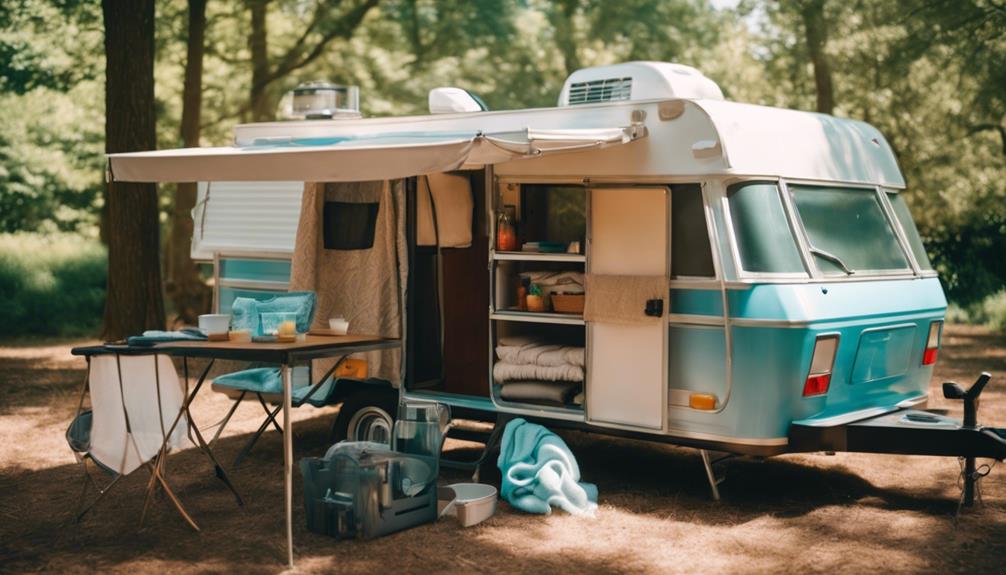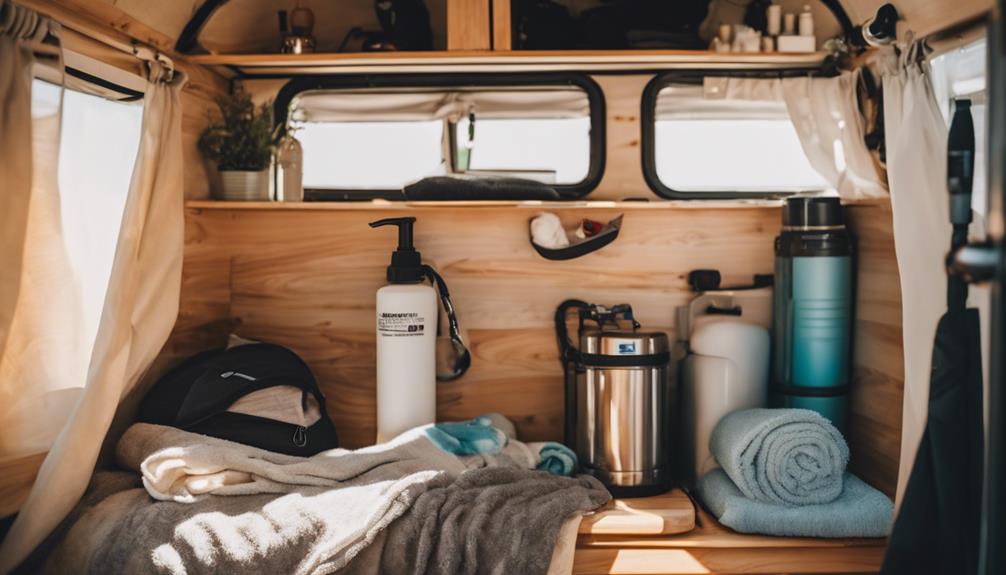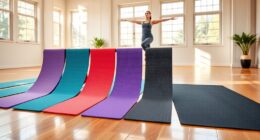To pull a pop-up camper safely, you need to know your vehicle's towing capacity and guarantee the camper's weight stays within those limits. Check the weight specifications like UVW and GVWR before starting your journey. Proper weight distribution is vital—aim for 10-15% tongue weight for stability. Conduct a thorough pre-trip checklist, including inspecting your hitch and connections. When you're on the road, manage your speed, use lower gears on inclines, and maintain a safe following distance. Practicing your backing and maneuvering skills will also help. For additional tips on making your towing experience smoother, explore more insights.
Key Takeaways
- Ensure your vehicle's towing capacity exceeds the combined weight of the camper and cargo for safe towing.
- Maintain proper weight distribution by ensuring tongue weight is 10-15% of the total trailer weight.
- Adjust mirrors for clear visibility around the trailer and utilize towing mirrors if necessary.
- Practice backing up and maneuvering in open spaces to build confidence and improve control.
Understanding Towing Capacity
What does towing capacity really mean, and why is it vital for safely towing a pop-up camper?
Towing capacity refers to the maximum weight your vehicle can safely pull, and it's important to know this limit. If you plan to tow a pop-up camper, you need to verify your vehicle's towing capacity exceeds the average weight of around 2,000 pounds for most campers.
For instance, the Kia Soul has a towing capacity of about 1,000 pounds. This makes it unsuitable for towing most pop-up campers, as doing so would exceed safe limits and could lead to serious vehicle damage or unsafe driving conditions.
Always remember to take into account the combined weight of the camper and any extra gear. This total must stay within your vehicle's gross vehicle weight rating (GVWR) to guarantee safe towing.
Exceeding your towing capacity can put you and others at risk, so double-check your vehicle's specifications in the owner's manual. By understanding your towing capacity and adhering to weight limits, you'll create a safer and more enjoyable camping experience.
Weight Considerations
When towing a pop-up camper, understanding weight considerations is essential for safe travel.
You'll need to check your vehicle's towing capacity and be aware of the camper's weight specifications to guarantee a proper match.
Additionally, maintaining safe weight distribution will help you avoid any stability issues on the road.
Towing Vehicle Capacity
Before you hit the road with your pop-up camper, it's essential to check your vehicle's towing capacity to guarantee a safe and enjoyable trip.
Your towing vehicle's capacity typically ranges from 1,000 to over 5,000 pounds, so consult your owner's manual for specifics. The average pop-up camper weighs around 2,000 pounds, but smaller models can dip below 1,500 pounds while larger ones may exceed 3,000 pounds. Knowing the exact weight of the camper you intend to tow is important.
When considering pop-up camper towing, make sure the total weight—camper plus cargo—doesn't surpass your vehicle's towing capacity. Exceeding this limit could lead to damage and loss of control. Additionally, it's wise to maintain a safety margin within your vehicle's capacity, ideally leaving 10-15% as a buffer for unexpected weight increases.
Familiarize yourself with important weight specifications like UVW (Unloaded Vehicle Weight), CCC (Cargo Carrying Capacity), and GVWR (Gross Vehicle Weight Rating). Doing so will help you effectively manage your towing vehicle's capabilities and enhance your overall towing experience.
Camper Weight Specifications
Understanding camper weight specifications is vital for guaranteeing your towing setup is safe and compliant with your vehicle's capacity. The average weight of pop-up campers is around 2,000 pounds, but you might find smaller models weighing less than 1,500 pounds or larger ones exceeding 3,000 pounds.
Before you hit the road, familiarize yourself with terms like UVW (Unloaded Vehicle Weight), CCC (Cargo Carrying Capacity), GAWR (Gross Axle Weight Rating), and GVWR (Gross Vehicle Weight Rating). These specifications help you confirm that your towing vehicles can handle the load.
Standard sedans can typically tow lighter pop-up campers, while heavier-duty vehicles, like 4×4 SUVs, are better suited for larger models. It's important to verify the total weight of your camper along with any extra gear you plan to bring.
This guarantees you don't exceed your towing vehicle's capacity. Always refer to your vehicle's owner's manual for specific towing capacity guidelines and make certain you comply with legal towing regulations.
Safe Weight Distribution
Maintaining safe weight distribution is essential for guaranteeing stability and control while towing your pop-up camper. Ideally, you want the tongue weight to be between 10-15% of the total trailer weight. This helps prevent swaying and improves handling on the road.
Start by calculating the Unloaded Vehicle Weight (UVW) of your camper, adding any cargo to confirm it doesn't exceed your vehicle's towing capacity. It's imperative to adhere to the Gross Vehicle Weight Rating (GVWR), which includes the weight of the trailer, cargo, and your towing vehicle combined.
Properly distribute cargo inside the camper by placing heavier items low and toward the front. This positioning enhances stability and reduces the risk of tipping while towing.
Don't forget to regularly check the Gross Axle Weight Rating (GAWR) to verify that the weight on each axle remains within the manufacturer's specifications. This is crucial for safe handling during your journey.
Pre-Trip Checklist
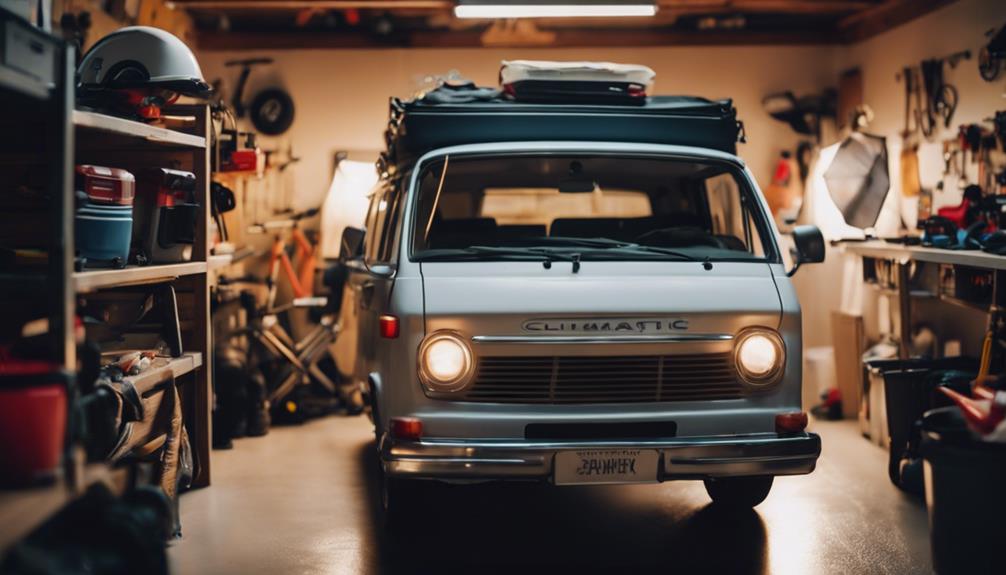
A solid pre-trip checklist guarantees your pop-up camper is ready for a safe and enjoyable journey.
Start by verifying your towing vehicle's capacity can handle the combined weight of the camper and any cargo. For standard sedans, aim for a total weight under 2,000 pounds.
Next, perform a thorough inspection of the camper. Check the tires for proper pressure and tread, and make certain the brakes and lights are functioning correctly.
Don't forget to verify that the tow hitch and connections are secure. Review your Owner's Manual for specific guidelines on hitch placement and load distribution to confirm everything is properly set up.
Packing is essential, so arrange your camping gear efficiently while keeping weight balance in mind to avoid instability while towing.
Lastly, plan your route ahead of time. Identify trailer-friendly gas stations and parking spaces to accommodate your camper's size.
Towing Techniques
When towing a pop-up camper, managing your speed is vital for safety and stability.
Make certain you adhere to speed limits and drive smoothly to prevent any swaying.
Also, don't forget to use your mirrors often to keep track of your camper's position and guarantee safe lane changes.
Safe Speed Management
Safe speed management is essential for ensuring a smooth and secure towing experience with your pop-up camper.
Stick to a maximum speed limit of 55 mph; most trailer tires aren't rated for higher speeds, which helps maintain stability and safety on the road.
Keep a steady speed while towing to prevent swaying—sudden acceleration or braking can destabilize the camper and lead to dangerous situations.
Always maintain a safe following distance from vehicles ahead. The added weight of the camper means you'll need more time to stop, so give yourself that extra space.
When steering through inclines or declines, utilize lower gears to maintain control and prevent your towing vehicle from overheating or losing traction.
Mirror Usage Tips
Properly adjusting your mirrors before hitting the road is essential for safe towing with a pop-up camper. Start by adjusting the side mirrors to guarantee you have a clear line of sight around your vehicle and the trailer. This will help you monitor the camper's position and surrounding traffic effectively. Before your trip, make certain the mirrors provide maximum visibility of the trailer's sides and any blind spots.
While driving, regularly check your mirrors, especially when changing lanes or making turns. The added length of the trailer means you need to be more vigilant. If your vehicle's factory mirrors don't give you adequate visibility, consider investing in extended or towing mirrors. These can greatly enhance your awareness of the trailer's surroundings.
Always keep in mind that the trailer will have a longer turning radius. Use your mirrors to gauge how much space you need when maneuvering corners and tight spots. By confirming your mirrors are correctly positioned and frequently monitored, you'll be better equipped to tow a pop-up camper safely and confidently.
Maneuvering and Backing Up

Maneuvering and backing up a pop-up camper can be challenging, but practicing in a large, open parking lot will boost your confidence and skills. Start by getting a feel for the size of your camper. When you're backing up, hold the steering wheel at the bottom and turn it in the direction you want the trailer to go. This method gives you better control over your maneuvering.
Make sure to utilize your side mirrors frequently. They provide improved visibility of the camper's position and surroundings, so don't rely solely on looking back. As you back up, take your time to align the trailer properly. If you find yourself off track, don't hesitate to pull forward to readjust. This can save you from frustration and errors later on.
If you're in a tight space, consider having a spotter assist you. They can offer valuable guidance and help avoid obstacles that you mightn't see.
With practice and patience, you'll soon feel more comfortable maneuvering and backing up your pop-up camper, making your towing experience a lot smoother.
Safety Practices
When towing a pop-up camper, implementing safety practices is essential to guarantee a smooth and secure journey. Start by always chocking the wheels of the camper before unhitching it. This simple step prevents any accidental rollaway that could lead to dangerous situations.
Using safety chains is another important step. These chains act as a secondary connection between your towing vehicle and the camper, offering added security in case of hitch failure. Make sure you attach them properly and check their condition regularly.
Don't overlook the importance of functioning lights and signals on your camper. Regularly check that they're operational to maintain clear communication with other drivers on the road. This will help avoid unexpected accidents.
Maintaining proper tire pressure on both your vehicle and the camper is essential to reduce the risk of blowouts and improve handling.
Finally, always carry a fire extinguisher and a first aid kit in your vehicle. Familiarize yourself with emergency procedures related to towing incidents, as being prepared can make all the difference in an emergency.
Following these safety practices will help guarantee you have a worry-free towing experience.
Post-Trip Maintenance
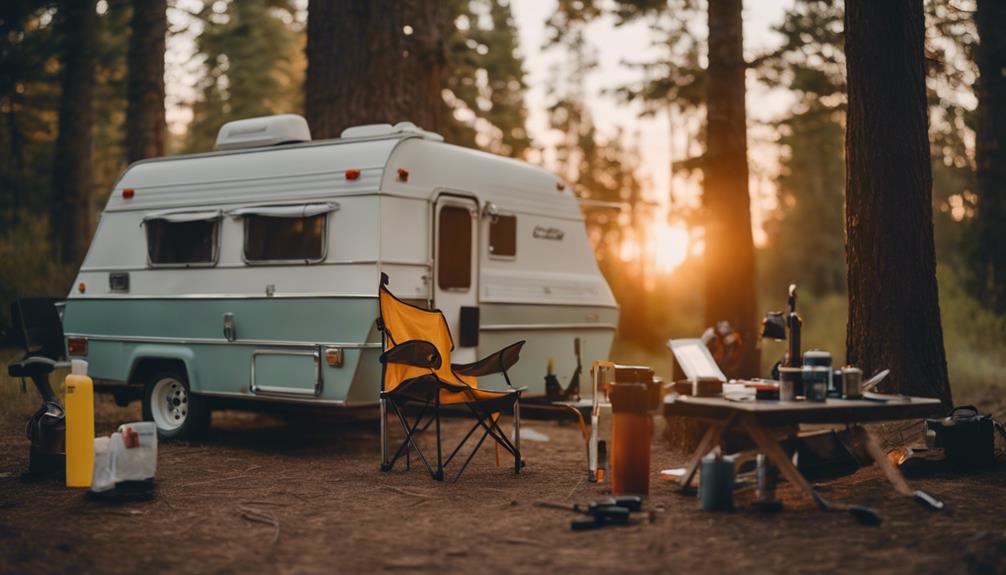
After every trip, it's crucial to thoroughly inspect your pop-up camper for any damage or wear that may have occurred during towing. Start by chocking the wheels to prevent accidental rollaway before unhitching. Check the tires for proper inflation and any signs of wear, and test the brakes and lights to verify they're functioning correctly.
Next, perform some post-trip maintenance by cleaning both the interior and exterior of your camper. Remove any dirt, debris, and moisture, as these can lead to deterioration over time. After cleaning, store your pop-up camper in a dry, shaded area to protect it from the elements, which can help prevent mold and corrosion.
Lastly, take a moment to review your towing experience. Consider factors like weight distribution and driving techniques to identify areas for improvement. This reflection won't only enhance your future trips but also contribute to the overall longevity of your pop-up camper.
Frequently Asked Questions
Is It Hard to Tow a Pop-Up Camper?
Towing a pop-up camper isn't hard, especially since they're lighter than larger RVs. With proper weight distribution and practice, you'll gain confidence. Just remember to stay aware of speed limits and maintain safe distances.
Do You Need Sway Bars to Pull a Pop-Up Camper?
Imagine sailing smoothly on calm waters; that's how towing your pop-up camper can feel. You don't always need sway bars, but if your camper's over 2,000 pounds or you're prone to swaying, they're a smart choice.
How Fast Can You Drive Pulling a Pop-Up Camper?
When you're towing a pop-up camper, stick to 55 mph to guarantee safety. Faster speeds can cause swaying, making control difficult. Always check local regulations and adjust your driving to maintain stability and safety.
How Do You Tow a Camper for the First Time?
Are you ready to tow a camper for the first time? Start by checking your vehicle's towing capacity, familiarizing yourself with the camper's weight, and practicing in open spaces to build confidence and skill.
Conclusion
As you pull away from the campsite, the sunset paints the sky in hues of orange and pink, and the laughter of your loved ones echoes in your ears.
You've mastered the art of towing, ensuring safety and comfort for your journey.
With each bump in the road, you feel the thrill of adventure.
Remember, it's not just about the destination—it's those cherished moments that linger long after the trip is over.
Happy travels!

